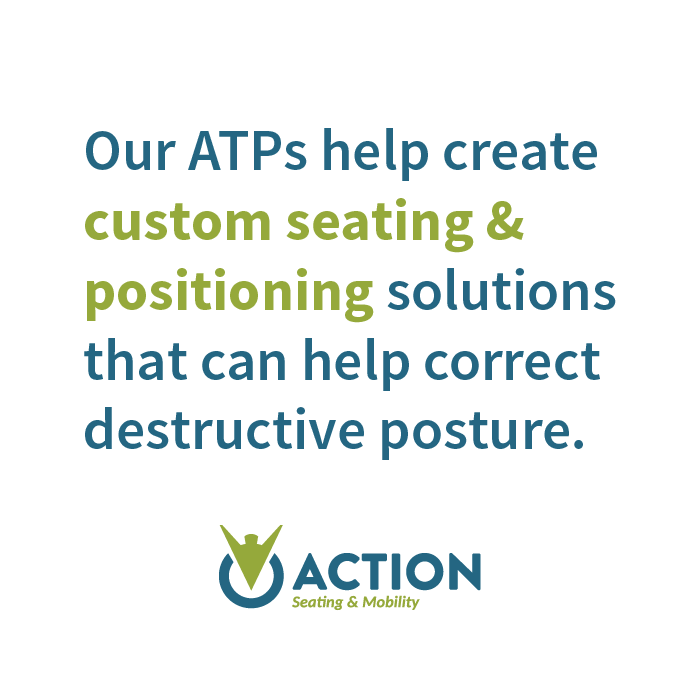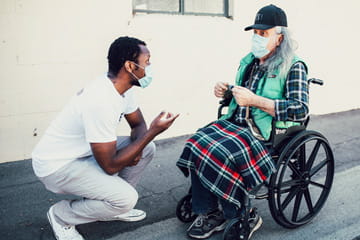
Here's what we'll cover:
- What is the Definition of Destructive Posture?
- What Can Cause Destructive Posture?
- What Physical Ailments Can Destructive Posture Cause?
- What Emotional and Psychosocial Issues Can Destructive Posture Cause?
- Understanding The Care Team for a Person with Destructive Posture
- How Does an ATP Help People with Destructive Posture?
Most of us take for granted the ability to freely move and reposition ourselves. If we’re uncomfortable while lying, standing, or sitting, we just adjust until we’re comfortable and go about our day without thinking about it.
For people with disabilities, however, repositioning can be difficult or even impossible without the aid of assistive equipment, resulting in destructive postures that can cause a host of health issues over time.
Uncorrected destructive posture can be extremely harmful to the physical, mental, and emotional health of people with disabilities. TweetBy understanding what destructive posture is, how it can affect people with disabilities, and how assistive technologies can help address the problem, you can more easily identify destructive posture and get the help you or your loved one needs.
What is the Definition of Destructive Posture?
By definition, destructive posture is any misalignment of bodily posture that causes gradual — and often permanent — damage to a person’s body.
What makes destructive posture uniquely damaging is how it can be easily missed and slowly lead to much more painful and even life-threatening health issues over time.
Let’s take a deeper look into some of the causes behind destructive posture, and then with that knowledge, learn how we can identify it and get the help needed to begin correcting the problem.
What Can Cause Destructive Posture?
The science of seating and positioning is largely focused on posture’s number one enemy: gravity.
The stronger and more well-toned the muscles in the body are, the easier it is to keep proper musculoskeletal alignment and resist the ever-present force.
But should the body’s ability to keep itself aligned properly become compromised due to disability or illness, gravity will slowly weigh the body down. As the body attempts to adapt, it can become fixed in a position that’s detrimental to proper musculoskeletal health.
While gravity is always the chief culprit, some physical and technical factors can also lead to a degradation of posture and general comfort.
Changes in muscle tone or flexibility
Some disabilities, such as amyotrophic lateral sclerosis (ALS), progress over time and lead to a slow degradation of the body’s muscles, bones, and connective tissues.
As a result, that person’s wheelchair or other assistive devices may no longer fit their body as the disability progresses, often leading to a great deal of discomfort.
Naturally, that person may try to adjust to find some level of comfort, by way of favoring one side of their body while seated or otherwise putting more pressure on a specific part of their body, leading to them adopting a posture that is harmful to their overall health.
Weight gain
Weight gain commonly accompanies disabilities, especially as people who may have only been recently disabled adjust to their new life.
With this onset of extra body weight comes added pressure on joints and soft tissues, often leading to postural changes such as a gradual favoring of one side of the body.
Should weight gain continue, it can become a vicious cycle of added weight, a degradation of posture, and worsening injuries.
Poorly-fitting assistive equipment
Whether it’s due to the progression of a degenerative disease, weight gain, or simply time and natural wear and tear, ill-fitting assistive equipment — such as a wheelchair, cushion, or postural support — can wreak havoc on posture.
Even if the equipment might be relatively new, if it’s not properly fitted to the user’s specific needs and their disability, it can lead to severely destructive posture and erosion of their overall quality of life.
This is why working with a trusted assistive technology professional (ATP) is a vital step toward protecting yourself or your loved one with a disability from destructive posture and other long-term health problems caused by poorly-fit seating and assistive technologies.

What Physical Ailments Can Destructive Posture Cause?
When destructive posture is left unaddressed for too long, it can often lead to further injuries that severely diminish the quality of life enjoyed by you or your loved one.
Severe joint pain, muscle soreness, and permanent body shape changes
Poor posture places added stress on sensitive musculoskeletal tissues, breaking down the plasticity of the skin and muscles, leading to severe pain and joint issues.
Should these issues be allowed to gradually get worse, poor posture can even bring about permanent damage in the form of body shape changes as the body attempts to adapt and seek relief from its painful positioning.
Skin rashes, sores, tears, and other skin integrity issues
Whether it’s due to the body attempting to reduce discomfort or the improper fit of assistive equipment, poor posture often leads to imbalances in pressure throughout the entire body.
This is especially true of areas, such as the buttocks and thighs, where there is a higher level of prolonged contact with a wheelchair cushion or other surface.
As this imbalance of pressures persists, it can lead to painful pressure sores, irritating rashes, and even skin tearing — an especially prominent issue in the elderly population.
Permanent muscle shortening
Left uncorrected, poor posture can lead to distortions and asymmetry in body shape as the body attempts to adapt to the positions it holds throughout the day.
Over time, this asymmetry can lead to permanent muscle shortening that can weaken certain parts of the body and make daily activities of living difficult without the aid of another person.
Difficulties swallowing, eating, breathing, and communicating
Should a person’s body become distorted over time due to uncorrected destructive posture, their internal organs and airways can reposition themselves in ways that can cause long-term damage.
If this increase in pressure and constriction manifest near the lungs and airways, breathing can become laborious and can even limit a person’s ability to speak.
Additionally, should the stomach or esophagus become subjected to increased pressure due to a person’s destructive posture, eating and digestion can be compromised, often resulting in gastric reflux disorders, such as gastrointestinal reflux disease (GERD).
Very poor sleep quality
Should breathing or swallowing become difficult due to the progression of destructive posture, the quality of sleep one enjoys becomes severely degraded and often leads to prolonged sleep deprivation.
As the body endures long periods of low-quality sleep, an array of complications can arise including:
Heightened blood pressure
Elevated risk of heart disease & diabetes
Weakened immune system
Increased weight gain
Difficulty thinking, concentrating, and recalling information

What Emotional and Psychosocial Issues Can be Caused by Destructive Posture?
Destructive posture is extremely detrimental to the body of a person with a disability; however, what’s often overlooked — but just as damaging — is the effect it can have on one’s mental and emotional well-being.
Reduced feelings of confidence and self-esteem
People with disabilities often struggle with body positivity and self-esteem at some point throughout their lives. These emotional struggles, however, can be compounded as destructive posture and its side effects are allowed to progress.
Posture has a well-documented effect on one’s self-image. When posture and comfort improve, there is a marked influence on one’s sense of self-worth and a strengthening of their sense of social belonging.
But should posture degrade, the inverse holds true: One’s sense of social belonging erodes and overall feelings of self-worth diminish as those suffering from destructive posture and its adverse effects aren’t able to engage the world around them as fully as before.
Reduced sense of independence
As destructive posture takes its toll on the body, mobility can be further compromised and activities of daily living can become all the more difficult to complete alone.
In turn, this often forces a person with a disability who is suffering from destructive posture to seek out help from a carer or loved one.
Though the help may be received gratefully and given with compassion, the person enduring this reduced mobility also endures the emotional pain of reduced independence.
Depression and a lower sense of overall well-being
Enduring the constant pain and loss of independence caused by unaddressed destructive posture, people with disabilities can often slip into prolonged states of depression and feel a generally lower sense of total health and wellbeing.
Our skilled and compassionate ATPs are ready to help improve your comfort and access to life.
Schedule Your EvaluationUnderstanding The Care Team and How It Works to Help Correct Destructive Posture
At Action Seating & Mobility, we believe that clear communication and teamwork among every member of a client's care team is essential to facilitating the best healthcare outcomes possible.
Though the care team for one client may differ from others, there are often several highly-trained healthcare specialists that help our clients achieve the best range of motion and access to life as they correct their destructive posture.
Let’s take a look at a typical care team and how they work together.
Assistive Technology Professionals
Assistive technology professionals (ATP), with experience in complex seating needs, work with the care team to help people with disabilities find the best seating, mobility, and rehabilitation technologies that fit their needs.
After meeting with the client and the care team, they use their seating and positioning expertise to custom-fit assistive technologies to the precise needs of the client and help chart a plan for any required adjustments, modifications, or necessary equipment in the future.
Quality ATPs, like those on the Action Seating & Mobility team, become a trusted friend and advocate for their clients, partnering together for years to come to always ensure they have the best equipment that keeps them comfortable, healthy, and engaged with life.
Physical Therapists
Physical therapists (PT) help people suffering from injuries or permanent disabilities through targeted exercises, massage, and other techniques.
Their goal is to help their patients achieve better range of motion, improved flexibility where possible, and generally improve their patient’s ability to comfortably move their body on their own.
Working with ATPs and the rest of the care team, physical therapists will help determine what a healthy range of motion is for their patient and will help develop a plan of care in order to help improve movement and overall health outcomes over the long term.
Occupational Therapists
Occupational therapists (OT) are often confused with physical therapists (and vice-versa).
Though there is a great deal of overlap between OTs and PTs, occupational therapists are specialists in helping a person with a disability achieve holistic health outcomes that empower them to complete their activities of daily living (ADLs) and healthfully embrace life.
Whereas a physical therapist is focused purely on the physical and biological mechanics of health and motion, an occupational therapist helps their patients return to a healthy level of physical independence, psychosocial, and environmental health in their daily living.
Caregivers & Loved Ones
Caregivers and loved ones are among those closest to our clients day in and day out.
Whether it’s helping with ADLs, cooking meals, cleaning, providing transportation, or any number of helpful activities, they’re right there observing how their loved one with a disability feels on a minute-by-minute basis.
At Action Seating & Mobility, we cherish caregivers and always seek to keep them informed of any pertinent information that affects them or their loved one as the care team strives to provide improved health outcomes.
The incredibly valuable insight they bring, the comfort they bring to our clients, and the role that their efforts play in helping their loved ones achieve a greater quality of life is incalculable, making them a valued pillar of the care team.
How Does a Quality Assistive Technology Professional Help People with Destructive Posture?
By working with the RESNA-certified and Ride-certified ATPs like the team here at Action Seating & Mobility, you or your loved one can be sure they’re receiving the highest quality of care and get the seating and positioning equipment that’s perfectly attuned to their health needs.
Now that we understand how an ATP works alongside the rest of the care team, let’s take a closer look at the specific benefits of having a quality ATP on the care team of you or your loved one.
Greater comfort and reduced risk of future injuries
By receiving the proper assistive technologies — such as postural supports, standing frames, or a custom-fit wheelchair — that are custom-fit to the needs of your or your loved one, the overall risk of injury is greatly reduced.
Moreover, by having tech that’s specifically fit and formed to support the postural care needs of you or your loved one, they’re able to enjoy greater comfort and, over time, begin re-engaging with their world on their terms.
Improved overall health
While the nature of one’s disability might limit what level of postural correction is possible, ATPs always administer care plans that are designed to provide the maximum comfort and postural care possible.
And as posture improves, pain and discomfort can begin to gradually subside.
In turn, those recovering from destructive posture often report a reduction in depressive symptoms and an improved sense of overall well-being.
Ongoing professional care and support that evolves with your needs
ATPs aren’t just highly-trained assistive technology experts.
They’re a pillar of the care team dedicated to understanding you and how you or your loved one want to better embrace the world around them and matching those goals with the perfect equipment.
In turn, they continually enrich the insight and capabilities of the PTs, OTs, and caregivers on the care team, equipping them with a trusted source of health information and equipment recommendations that support targeted health outcomes and improve every level of care for your or your loved one.
No matter how your needs might change over the years, ATPs are always there to fit you with the best equipment that provides optimal comfort and support.
Let’s Work Together to Improve Destructive Posture and Keep You Moving
As we’ve seen, the physical and emotional effects of destructive posture aren’t something that can be ignored. They sap the excitement and beauty from life and can make everyday activities nearly impossible.
But you don’t have to live with that discomfort anymore.
For decades, our teams of compassionate ATPs have been helping people throughout Oklahoma, Colorado, and Arkansas find the seating and positioning technologies that allow them to correct their posture, reduce discomfort, and enjoy life to its fullest.
We’re ready to get to work for you. Let’s schedule your seating evaluation today and keep you moving!


